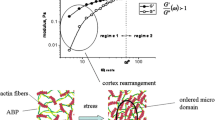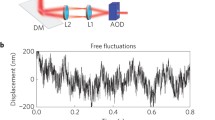Abstract
An attempt was made to discuss and connect various modeling approaches on various time and space scales which have been proposed in the literature in order to shed further light on the erythrocyte membrane rearrangement caused by the cortex-lipid bilayer coupling under thermal fluctuations. Roles of the main membrane constituents: (1) the actin-spectrin cortex, (2) the lipid bilayer, and (3) the trans membrane protein band 3 and their course-consequence relations were considered in the context of the cortex non linear stiffening and corresponding anomalous nature of energy dissipation. The fluctuations induce alternating expansion and compression of the membrane parts in order to ensure surface and volume conservation. The membrane structural changes were considered within two time regimes. The results indicate that the cortex non linear stiffening and corresponding anomalous nature of energy dissipation are related to the spectrin flexibility distribution and the rate of its changes. The spectrin flexibility varies from purely flexible to semi flexible. It is influenced by: (1) the number of band 3 molecules attached to single spectrin filaments, and (2) phosphorylation of the actin-junctions. The rate of spectrin flexibility changes depends on the band 3 molecules rearrangement.



Similar content being viewed by others
References
Amin MS, Park YK, Lue N, Dasari RR, Badizadegan K, Feld MS, Popescu G (2007) Microrheology of red blood cell membrane using dynamics scattering microscopy. Opt Express 15(25):17001–17009
Betz T, Lenz M, Joanny JF, Sykes C (2009) ATP-dependent mechanics of red blood cells. PNAS 106(36):15320–15325
Blackman SM, Cobb CE, Beth AH, Piston DW (1996) The orientation of Eosin-5-maleimide on human erythrocyte band 3 measured by fluorescence polarization microscopy. Biophys J 71:194–208
Boal D (2012) Mechanics of the cell, 2nd edn. Cambridge University Press, New York
Borukhov I, Bruinsma RF, Gelbart WM, Liu AJ, Lubensky TC (2005) Structural polymorphism of the cytoskeleton: a model of linker-assisted filament aggregation. PNAS 102(10):3673–3678
Boss D, Hoffmann A, Rappaz B, Depeursinge C, Magistretti PJ, Van de Ville D, Marquet P (2012) Spatially-resolved eigenmode decomposition of red blood cells membrane fluctuations questions the role of ATP in flickering. PLoS ONE 7(8) e406671: 1–10
Bouchiat C, Wang MD, Allemand JF, Strick T, Block SM, Croquette V (1999) Estimating the persistence length of a worm-like chain molecule from force-extension measurements. Biophys J 76:409–413
Braunmuuller S, Schmid L, Sackmann E, Franke T (2012) Hydrodynamics deformation reveals two coupled modes/time scales of red blood cells relaxation. Soft Matter 8:11240–11248
Budini AA, Caceres MO (2004) Functional characterization of generalized Langevin equation. J Phys A Math Gen 37:5959–5981
Dalhaimer P, Discher DE, Lubensky TC (2007) Crosslinked actin network show liquid crystal elastomer behavior, including soft-mode elasticity. Nat Phys 3:354–360
Danon D (1961) Osmotic hemolysis by a gradual decrease in the ionic strength of the surrounding medium. J Cell Comp Physiol 57:111–117
DiDonna BA, Lubensky TC (2005) Nonaffine correlations in random elastic media. Phys Rev E 72(066619):1–23
Evans EA, Hochmuth RM (1976) Membrane viscoelasticity. Biophys J 16:1–11
Evans EA, Skalak R (1980) Mechanics and themodynamics of biomembranes. CRC Press, Inc., Boca Raton
Franco T, Low PS (2010) Erythrocyte adducin: a structural regulator of the red blood cell membrane. Transfus Clin Biol 17(3):87–94
Golan DE, Veatch W (1980) Lateral mobility of band 3 in the hyman erythrocyte membrane studied by fluorescence photobleaching recovery: Evidence for control by cytoskeletal interactions. Proc Natl Acad Sci 77(5):2537–2541
Gov NS (2007) Less is more: removing membrane attachments stiffness the RBC cytoskeleton. New J Phys 9(429):1–8
Gov NS, Safran SA (2005) Red blood cell membrane fluctuations and shape controlled by ATP-induced cytoskeletal defects. Biophys J 88:1859–1874
Jonas M, Chung E, Kim YH, So PTC (2006) Cytoskeletal mechanics fast fluorescence microrheology. GEM4 – August 2006 – MIT So Lab – FLTM, p. 1–3
Kabaso D, Shlomovitz R, Auth T, Lew VL, Gov NS (2010) Curling and local shape changes of red blood cell membranes driven by cytoskeletal reorganization. Biophys J 99:808–816
Kabaso D, Shlomovitz R, Auth T, Lew VL, Gov NS (2011) Cytoskeletal reorganization of red blood cell shape: curling of free edges and malaria merozoites. In: Iglic A (ed.) Advances in planar lipid bilayers and liposomes, Volume 13, pp. 73–102
Kodippili GC, Spector J, Hale J, Giger K, Hughes MR, McNagny KM, Birkenmeier C, Peters L, Ritchie K, Low PS (2012) Analysis of the mobilities of band 3 populations asociatted with ankyrin protein and junctional complexes in intact murine erythrocytes. J Biol Chem 287(6):4129–4138
Leiber MR, Steck TL (1982) A description of the holes in human erythrocyte membrane ghosts. J Biol Chem 257:11651–11659
Li J, Dao M, Lim CT, Surech S (2005) Spectrin-level modeling of the cytoskeleton and optical tweezers stretching of the erythrocyte. Biophys J 88:3707–3719
Markle DR, Evans EA, Hochmuth RM (1983) Force relaxation and permanent deformation of erythrocyte membrane. Biophys J 42:91–98
Nir G, Lindner M, Dietrich HRC, Girshevitz O, Vorgias CE, Garini Y (2011) HU protein induces incoherent DNA persistence length. Biophys J 100:784–790
Pajic-Lijakovic I (2015) Erythrocytes under osmotic stress–modeling considerations. Prog Biophys Mol Biol 117(1):113–124
Pajic-Lijakovic I, Milivojevic M (2014) Modeling analysis of the lipid bilayer-cytoskeleton coupling in erythrocyte membrane. Biomech Model Mechanobiol Biol 13(5):1097–1104
Pajic-Lijakovic I, Milivojevic M (2015) Actin cortex rearrangement caused by coupling with the lipid bilayer-modeling considerations. J Membr Biol 248(2):337–347
Pajic-Lijakovic I, Ilic V, Bugarski B, Plavsic MB (2010) The rearrangement of erythrocyte band 3 molecules and reversible osmotic holes formation under hypotonic conditions. Eur Biophys J 39(5):789–800
Park YK, Best CA, Badizadegan K, Dasari RR, Feld MS, Kuriabova T, Henle ML, Levine AJ, Gabriel Popescu G (2010) Measurement of red blood cell mechanics during morphological changes. PNAS 107(15):6731–6736
Podlubny I (1999) Fractional differential equations, mathematics in science and engineering. Academic, London, 198 pp. 78
Popescu G, Park YK, Dasari RR, Badizadegan K, Feld MS (2007) Coherence properties of red blood cell membrane motion. Phys Rev E 76(031902):1–5
Pradhan D, Tseng K, Cianci CD, Morrow JS (2004) Antibodies to hIA2 spectrin identify in-homogeneities in the erythrocyte membrane skeleton. Blood Cell Mol Dis 32:408–410
Pribush A, Meyerstein D, Meyerstein N (2002) Kinetic of erythrocyte swelling and membrane hole formation in hypotonic media. Biochim Biophys Acta 1558:119–132
Pritchard RH, Huang YYS, Terentjev EM (2014) Mechanics of biological networks: from the cell cytoskeleton to connective tissue. Soft Matter 10:1864–1884
Puig-de-Morales-Marinkovic M, Turner KT, Butler JP, Fredberg JJ, Suresh S (2007) Viscoelasticity of the human red blood cell. Am J Physiol Cell Physiol 293:C597–C605
Salhany JM, Cordes KA, Sloan RL (2000) Mechanism of band 3 dimmer dissociation during incubation of erythrocyte membranes at 37 degrees C. Biochem J 345:33–41
Sato Y, Yamakose H, Suzuki Y (1993) Mechanism of hypotonic hemolysis of human erythrocytes. Biol Pharm Bull 16(5):506–512
Seeman P, Cheng D, Iles GH (1973) Structure of membrane holes in osmotic and saponian hemolysis. J Cell Biol 56:519–527
Shlomovitz R, Gov NS (2008) Curved inclusions surf membrane waves. Europhys Lett 84(58008):1–p6
Sleep J, Wilson D, Simmons R, Gratzer W (1999) Elasticity of the red cell membrane and its relation to hemolytic disorders: an optical tweezers study. Biophys J 77:3085–3095
Stirnemann G, Giganti D, Fernandez JM, Berne BJ (2013) Elasticity, structure and relaxation of extended proteins under force. PNAS 110(10):3847–3852
Taylor AM, Boulter J, Harding SE, Colfen H, Watts A (1999) Hydrodynamics properties of Hyman erythrocyte band 3 solubilized in reduced triton X-100. Biophys J 76:2043–2055
Tomishige M, Sako Y, Kusumi A (1998) Regulation mechanism of the lateral diffusion of band3 in erythrocyte membranes by the membrane skeleton. J Cell Biol 142(4):989–1000
Warren RL, Tassieri M, Li X, Glidle A, Paterson DJ, Carlsson A, Cooper JM (2013) Rheology at the micro-scale: new tools for bioanalysis. In: Optical Methods for Inspection, Characterization and Imaging of Biomaterials, 13–16 May 2013, Munich, Germany, Proc SPIE Vol. 8792, p. 8792141 1–13
Waugh RE, Agre P (1988) Reductions of erythrocyte membrane viscoelastic coefficients reflect spectrin deficiencies in hereditary spherocytosis. J Clin Invest 81:133–141
Wen Q, Basu A, Janmey PA, Yodh AG (2012) Non-affine deformations in polymer hydrogels. Soft Matter 8(31):8039–8049
Yoon YZ, Kotar J, Yoon G, Cicuta P (2008) The nonlinear mechanical response of the red blood cell. Phys Biol 5(036007):1–8
Yoon YZ, Kotar J, Brown AT, Cicuta P (2011) Red blood cell dynamics: from spontaneous fluctuations to non-linear response. Soft Matter 7:2042–2051
Acknowledgments
This research was funded by grant III46001 from the Ministry of Science and Environmental Protection, Republic of Serbia. The author thanks Professor Nir Gov (Department of Chemical Physics, The Weizmann Institute of Science) for discussions that inspired this work and Professor Jelena Filipovic (Faculty of Philology, University of Belgrade) for language corrections.
Author information
Authors and Affiliations
Corresponding author
Rights and permissions
About this article
Cite this article
Pajic-Lijakovic, I. Role of band 3 in the erythrocyte membrane structural changes under thermal fluctuations –multi scale modeling considerations. J Bioenerg Biomembr 47, 507–518 (2015). https://doi.org/10.1007/s10863-015-9633-9
Received:
Accepted:
Published:
Issue Date:
DOI: https://doi.org/10.1007/s10863-015-9633-9




